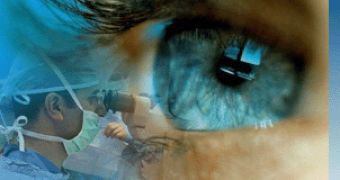The age of trees or fish is not the only one that can be determined through the analysis of specific elements, like growth rings or scales. A radiocarbon dating technique can use special proteins in the crystalline lens of the eye for determining a person's age. The method developed by a team at the University of Copenhagen and Aarhus and published in the journal 'PLoS ONE" can determine with high precision when you were born. Forensic scientists could this way give a precise age to unidentified bodies.
The crystalline lens is made of tightly packed transparent proteins, acting like crystals focusing the light on the retina. These proteins are built only until the age of 1-2 years, then the growth of the lens stops till you die.
The new method measures the amount of the isotope Carbon-14 (C-14) accumulated in the lens proteins.
This isotope decays slowly and its concentration in the body corresponds to that found in the atmosphere. In dead organisms, the C-14 percentage decays very slowly, but still it decreases in time. The radiocarbon dating measures the amount of C14 in fossils or historic remains for a precise dating up to 60, 000 years.
Between 1945 to 1960, US and USSR conducted nuclear tests that raised the amount of radioactive trace materials in the atmosphere, including C-14. During that period, the C-14 levels have doubled in Earth's atmosphere. Since 1960, they have slowly been decreasing to previous levels. But this variation in C-14 atmosphere levels influenced the food chain, and also the crystalline lens of people's eyes. By employing a large nuclear accelerator, the Danish team could assess the C-14 levels in just one milligram of lens tissue to determine the year of birth.
"As has been pointed out by other researchers, we think that the carbon dating of proteins and other molecules in the human body can also be used to study when certain kinds of tissue are generated and regenerated. This could, for example, be applied to cancer tissue and cancer cells. Calculating the amount of C-14 in these tissues could perhaps tell us when the cancerous tissues formed, and this could further the understanding of cancer," said co-author Associate Professor Niels Lynnerup, from the Department of Forensic Sciences at University of Copenhagen.

 14 DAY TRIAL //
14 DAY TRIAL //